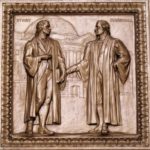In this lesson, students will view video clips explaining the Supreme Court case Marbury v. Madison. Students will analyze the significance of the case, the precedent it set and its legacy.
John Marshall, Marbury v. Madison and Judicial Review—How the Court Became Supreme

If James Madison was the “father” of the Constitution” John Marshall was the “father of the Supreme Court”—almost single-handedly clarifying its powers. This new lesson is designed to help students understand Marshall’s brilliant strategy in issuing his decision on Marbury v. Madison, the significance of the concept of judicial review, and the language of this watershed case.
American Legal History: Colonial Era to 1800
Larry Kramer, former Dean of Stanford Law School and constitutional scholar, discusses American legal history, beginning with Marbury v. Madison.
Landmark Supreme Court Cases
In a partnership with the National Constitution Center, Khan Academy talked to constitutional scholars about ten of the most significant Supreme Court cases in history. Teachers can use this lesson as a supplemental resource during their Supreme Court unit to show how constitutional scholars can debate the outcomes of Supreme Court cases, as well as the impact these cases have had on the United States.
Grade 9-12 The Judiciary Act of 1789
The purpose of this lesson is to teach students about the significance of the Judiciary Act of 1789 in establishing a federal judiciary, and the power of judicial review as outlined by the landmark U.S. Supreme Court Case, Marbury v. Madison (1803). By the conclusion of this lesson, students will understand the key provisions of the Judiciary Act of 1789 and the structure of the federal judiciary, as well as the power of judicial review.
The Pursuit of Justice
The Pursuit of Justice book, written by Kermit L. Hall and John J. Patrick, analyzes 30 Supreme Court cases chosen by a group of Supreme Court justices and leading civics educators as the most important for American citizens to understand. An additional 100 significant cases included in state history and civics standards are summarized. The complete book or individuals chapters can be downloaded.